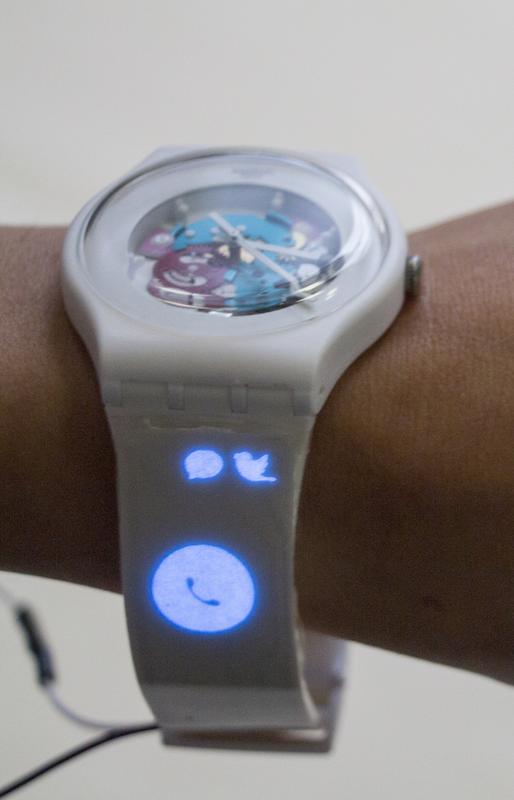Printing in the hobby room: paper- thin and touch-sensitive displays on various materials

Paper- thin and touch-sensitive displays on various materials Saarland University
Those only some of the options computer scientists in Saarbrücken can offer. They developed an approach that in the future will enable laypeople to print displays in any desired shape on various materials and therefore could change everyday life completely.
For example: A postcard depicts an antique car. If you press a button, the back axle and the steering wheel rim light up in the same color. Two segments on a flexible display, which have the same shape as those parts of the car, can realize this effect. Computer scientists working with Jürgen Steimle printed the post card using an off-the-shelf inkjet printer. It is electro-luminescent: If it is connected to electric voltage, it emits light. This effect is also used to light car dashboards at night.
Steimle is leader of the research group “Embodied Interaction” at the Cluster of Excellence “Multimodal Computing and Interaction”. Simon Olberding is one of his researchers. “Until now, this was not possible”, explains Olberding.
“Displays were mass-produced, they were inflexible, they always had a rectangular shape.” Olberding and Steimle want to change that. The process they developed works as follows: The user designs a digital template with programs like Microsoft Word or Powerpoint for the display he wants to create. By using the methods the computer scientists from Saarbrücken developed, called “Screen Printing” and “Conductive Inkjet Printing”, the user can print those templates.
Both approaches have strengths and weaknesses, but a single person can use them within either a few minutes or two to four hours. The printing results are relatively high-resolution displays with a thickness of only 0.1 millimeters. It costs around €20 to print on a DIN A4 page; the most expensive part is the special ink.
Since the method can be used to print on materials like paper, synthetic material, leather, pottery, stone, metal and even wood, two-dimensional and even three-dimensional shapes can be realized. Their depiction can either consist of one segment (surface, shape, pattern, raster graphics), several segments or variously built-up matrixes. “We can even print touch-sensitive displays”, says Olberding.
The possibilities for the user are various: displays can be integrated into almost every object in daily life – users can print not only on paper objects, but also on furniture or decorative accessories, bags or wearable items. For example, the strap of a wristwatch could be upgraded so that it lights up if a text message is received. “If we combine our approach with 3D printing, we can print three-dimensional objects that display information and are touch-sensitive”, explains Steimle.
Background information about computer science research at Saarland University
The Department of Computer Science represents the center of computer science research in Saarbrücken, Germany. Seven other internationally renowned research institutes are nearby: The Max Planck Institutes for Informatics and for Software Systems, the German Research Center for Artificial Intelligence (DFKI), the Center for Bioinformatics, the Intel Visual Computing Institute, the Center for IT Security, Privacy and Accountability (CISPA), and the Cluster of Excellence “Multimodal Computing and Interaction”.
Press requests:
Dr. Jürgen Steimle
Cluster of Excellence “Multimodal Computing and Interaction”
Mail: jsteimle@mmci.uni-saarland.de
Phone: +49 681 302-71935
Simon Olberding
Cluster of Excellence “Multimodal Computing and Interaction”
Mail: solberding@mmci.uni-saarland.de
Phone: +49 681 302-71937
Editor:
Gordon Bolduan
Science Communication
Cluster of Excellence on “Multimodal Computing and Interaction”
Mail: bolduan@mmci.uni-saarland.de
Tel.: +49 (0)681/302-70741
http://embodied.mpi-inf.mpg.de/research/printscreen/
http://www.uni-saarland.de/pressefotos
http://youtu.be/LiD7dnqY034
Media Contact
All latest news from the category: Materials Sciences
Materials management deals with the research, development, manufacturing and processing of raw and industrial materials. Key aspects here are biological and medical issues, which play an increasingly important role in this field.
innovations-report offers in-depth articles related to the development and application of materials and the structure and properties of new materials.
Newest articles

Silicon Carbide Innovation Alliance to drive industrial-scale semiconductor work
Known for its ability to withstand extreme environments and high voltages, silicon carbide (SiC) is a semiconducting material made up of silicon and carbon atoms arranged into crystals that is…

New SPECT/CT technique shows impressive biomarker identification
…offers increased access for prostate cancer patients. A novel SPECT/CT acquisition method can accurately detect radiopharmaceutical biodistribution in a convenient manner for prostate cancer patients, opening the door for more…

How 3D printers can give robots a soft touch
Soft skin coverings and touch sensors have emerged as a promising feature for robots that are both safer and more intuitive for human interaction, but they are expensive and difficult…





















